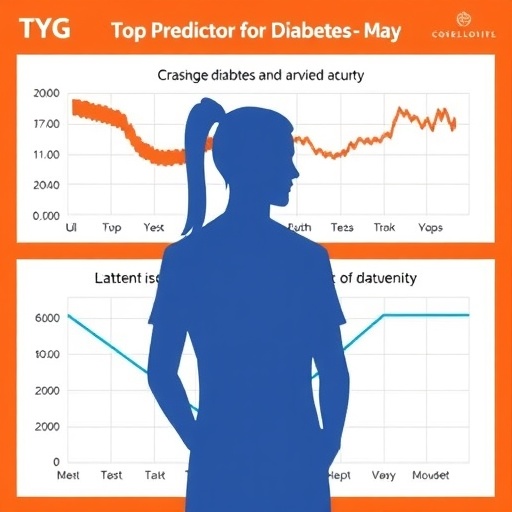In recent years, medical research has steadily embraced a multifaceted approach toward understanding and predicting the risk of chronic diseases such as diabetes mellitus. This pursuit has led scientists to explore various biomarkers and indices that may elucidate the underlying connections between metabolic health and overall mortality risk. A significant contribution to this research landscape is the recent study by Tu, Wu, and Chen et al., which introduces the Triglyceride Glucose-Weight-Adjusted Waist Index (TyG-WWI) as a noteworthy predictor of diabetes and associated mortality risks.
The quest for effective predictors of chronic diseases continues to be a crucial area of medical inquiry. The traditional methods of evaluating metabolic health often rely on separate measures of glucose and triglycerides, neither of which wholly encapsulates an individual’s metabolic status. The study presents TyG-WWI as a comprehensive tool that amalgamates the advantages of these traditional metrics while taking body weight into consideration. Given that metabolic disorders carry significant implications for mortality, refining our predictive capabilities in this area is pivotal.
Understanding the fundamental elements of the TyG-WWI is essential. The index is derived from a straightforward formula that integrates waist circumference, triglyceride levels, and a weight adjustment factor. Each component of the TyG-WWI plays a specific role in reflecting an individual’s distribution of body fat, insulin sensitivity, and metabolic status. Waist circumference serves as an indicator of visceral fat, which is intimately linked with insulin resistance and associated metabolic dysfunctions, while triglyceride levels provide insight into lipid metabolism.
The study utilized a large cohort to validate the efficacy of TyG-WWI against existing indices, including the standard TyG index and other derived measures. The findings revealed that the TyG-WWI demonstrated a superior predictive capability for determining diabetes mellitus involvement and subsequent mortality risks. This emergent index holds promise not only for individual assessments but also for broader public health strategies aimed at mitigating the rising tide of diabetes.
One of the intriguing aspects of the research is its emphasis on the weight-adjusted component of the TyG-WWI. Traditional measures often overlook the aspect of body weight, which may lead to misinterpretations regarding an individual’s metabolic risks. Weight distortion may cause discrepancies in metabolic health assessments, making TyG-WWI’s consideration of weight particularly pertinent.
Furthermore, the implications of this study extend to clinical practice. If validated through further research, TyG-WWI could become a staple tool for healthcare providers in identifying at-risk patients more accurately. By honing in on individuals more likely to develop severe metabolic disorders, interventions can be tailored to preemptively combat diseases like diabetes rather than solely relying on reactionary medical treatment post-diagnosis.
The researchers also emphasize the importance of multifactorial risk assessment in the prevention of diabetes. Relying on a singular biomarker often fails to provide a complete picture of an individual’s health. Instead, indices like TyG-WWI could collectively be utilized with other lifestyle factors, genetic predispositions, and comorbidities to form a nuanced understanding of risk profiles. This holistic approach could fortify preventive health strategies and potentially dampen mortality related to chronic metabolic conditions.
To add further granularity to their research, Tu et al. explored the demographic variabilities in their cohort, noting how TyG-WWI might reflect differing metabolic health trajectories across age, gender, and ethnic backgrounds. Such considerations are critical in ensuring that health interventions are as inclusive and effective as possible. The acknowledgment of demographic influences on health indicators is vital for accurately addressing community-specific health needs.
An additional focus of the article is the evolving landscape of diabetes management. As global rates of diabetes continue to surge, incorporating innovative and predictive indices like TyG-WWI into clinical frameworks becomes paramount. Governments and health organizations could leverage these findings to foster public awareness campaigns that underscore the importance of early detection and metabolic health, potentially reducing the burden of diabetes on healthcare systems.
The study’s findings may also have implications for further research into personalized medicine. As healthcare moves towards individualized treatment plans, employing a tailored approach grounded in robust predictive data will allow for more effective management of chronic diseases. The TyG-WWI could serve as a cornerstone for developing targeted interventions aimed at at-risk populations, thus enhancing the quality of care provided.
In conclusion, the introduction of the Triglyceride Glucose-Weight-Adjusted Waist Index represents a significant advancement in the fields of endocrinology and metabolic health. As researchers and healthcare providers alike strive to combat the rising prevalence of diabetes and associated complications, incorporating refined predictive tools such as TyG-WWI could yield substantial benefits in early detection and intervention. The implications of this research may reverberate through clinical practices and public health initiatives, ultimately leading to improved health outcomes for individuals across diverse populations.
The landscape of diabetes research is continually evolving, driven by a quest to better understand the complex interactions within our bodies. As we unearth new methodologies for assessing metabolic health, the potential for innovation in diabetes prevention and management grows ever larger. With tools like the TyG-WWI at our disposal, healthcare practitioners may find themselves more equipped to navigate the intricate web of diabetes risk factors, leading to more accurate predictions and better care strategies moving forward.
As the medical community digests these findings, the anticipation of further studies validating the TyG-WWI is palpable. Its role in understanding diabetes and mortality risk will be assessed through continued longitudinal research, serving as a reminder of the ongoing need to adapt and transform our approaches to healthcare in response to emerging data and technological advancements.
Subject of Research: Diabetes Mellitus and Mortality Risks
Article Title: Triglyceride glucose-weight-adjusted waist index (TyG-WWI): the best predictor of diabetes mellitus and mortality risks among TyG and TyG-derived indices.
Article References: Tu, J., Wu, B., Chen, H. et al. Triglyceride glucose-weight-adjusted waist index (TyG-WWI): the best predictor of diabetes mellitus and mortality risks among TyG and TyG-derived indices. BMC Endocr Disord 25, 166 (2025). https://doi.org/10.1186/s12902-025-01989-y
Image Credits: AI Generated
DOI: 10.1186/s12902-025-01989-y
Keywords: Diabetes Mellitus, Mortality Risks, TyG-WWI, Triglycerides, Metabolic Health, Predictive Index, Health Interventions, Personalized Medicine.




